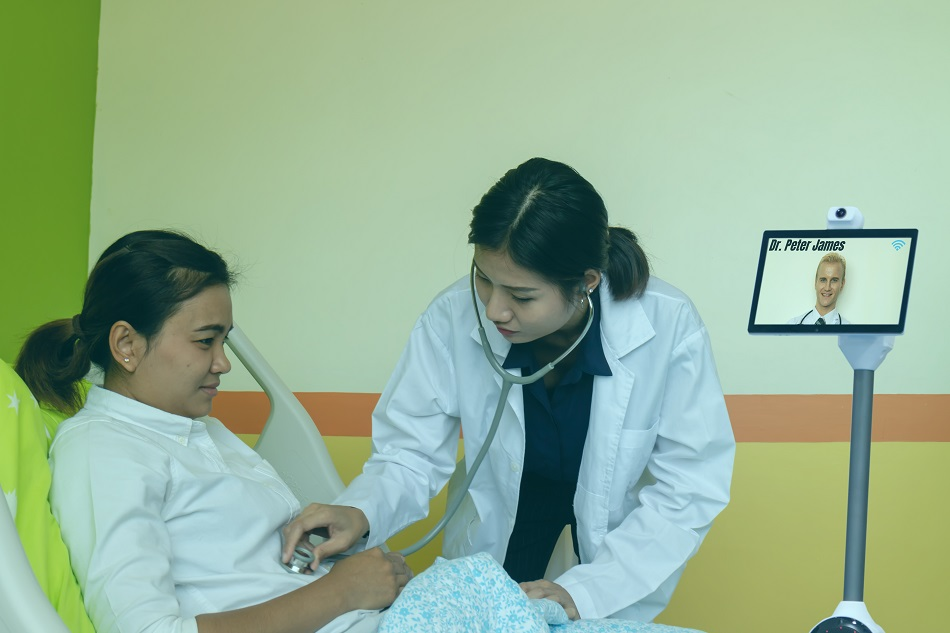Aug 2 2012

Image Credit: MONOPOLY919/Shutterstock.com
Mobile robots operating via telepresence from a distance location are becoming a beneficial tool in the health care sector. This type of assistive technology constitutes a very important and prosperous avenue where the ultimate goal is decreasing the load on the health care system and improving the quality of life of patients by reducing hospitalization periods.
RP-VITA Robot: Telepresence in Remote Health Care
Technological advancements have allowed the implementation of robots in many areas of our lives. The American advanced technology company iRobot has designed robots for space exploration and military purposes since the founding of the company in 1990.
Research and development efforts by iRobot don’t just stop at consumer electronics; this firm has collaborated with InTouch Health - a company dedicated to designing and manufacturing telemedicine remote presence medical devices - recently announced a new telemedicine robot doctor (RP-VITA) that allows physicians to interact with patients in a hospital setting to offer healthcare. The following video demonstrates the application of the telepresence robotic technology in a hospital setting.
The RP-VITA remote telemedicine device is made up of cameras, microphones, sensors to allow for 3D mapping, and a stethoscope to help monitor the internal sounds of the human body. The front screen to the RP-VITA device allows for user interface between the remote physician and the patient.
The device can automatically undock and can be sent to any location in a hospital by a touchscreen control unit. When inside a care unit, the RP-VITA device can access clinical data wirelessly to help deliver care to the patient. The remote telemedicine device needs to work with a nurse or physician present around the patient to coordinate team-based care. Once inside the care unit and wirelessly connected to the clinical data, the RP-VITA device alerts team-based care members including a nurse and respiratory therapist. The clinical data is displayed for the remote team of physicians to review the patient’s condition.
As demonstrated in the above video, the physician is requesting the nurse to monitor the patient’s breathing, feedback data for which is displayed on a screen for the physician to interpret the data and offer a diagnosis from their remote location. This makes remote monitoring of patients more feasible. However, further research into how well patients can initiate and complete a series of tasks set by the physician is needed to aid in patient care.
RP-VITA: New Robot from iRobot and InTouch Health
Accuracy of Diagnosis
There is a concern over how accurate a physician can be when diagnosing a condition from a distance. However, evidence by Belachel and colleagues does demonstrate a high degree of precision in remote diagnosis. In this study, 191 Acute Leukemia cases were established from the database of Cliniques Universitaires Saint-Luc in Brussels by a web-based clinical decision support system. During experimental testing, the percentage of correct classification of Acute Leukemia cases was at 96% demonstrating how web-integration can be beneficial for the dissemination of a support system. Schwaab and colleagues conducted a study to compare the accuracy of a standard 12-lead electrocardiogram (ECG) to a 12-lead tele-ECG device. The study included 158 post-myocardial infarction cardiac patients at home receiving patient care via tele-ECG technology. The finding revealed that 155 of 158 patients reported adequate quality of the tele-ECG technology for correct diagnosis in the corresponding patients.
Remote care for elderly people
In times when the aging population is increasing, the pressure on the health care systems worldwide to maintain the quality of the services provided and control the costs is becoming a major issue. Telepresence robots are becoming one of the potential solutions for this problem by providing remote care for elderly people.
To ensure the suitability of the telepresence robots several functionalities need to be implemented, such as autonomous navigation, vital sign monitoring and artificial audition.
Furthermore, telepresence robots have found an implication in intensive care units. Studies have shown that telepresence robots aid the facilitation of a rapid response from physicians to patients who are in an unstable condition. Moreover, the use of telepresence robots has contributed to a reduction in the costs of neurointensive care.
Why is the RP-VITA technology so important?
Hospitals are continually trying to improve patient care whilst also keeping treatment costs as low as possible. When resources available are scarce, the demand to achieve high-quality patient care can be difficult to attain. The RP-VITA technology aims to maintain high-quality patient care by using remote technology with voice recognition ability to track and monitor the patient. Information is then sent to clinicians to help diagnose the patient’s condition. This technology is particularly beneficial as on-call assistance and patient discharge. Such novel technology has the potential to become a common application in hospitals worldwide especially in third-world countries where medical practices are problematic and also in some of the more challenging situations in critical care units.
Sources and Further Reading
This article was updated on 6th February, 2020.